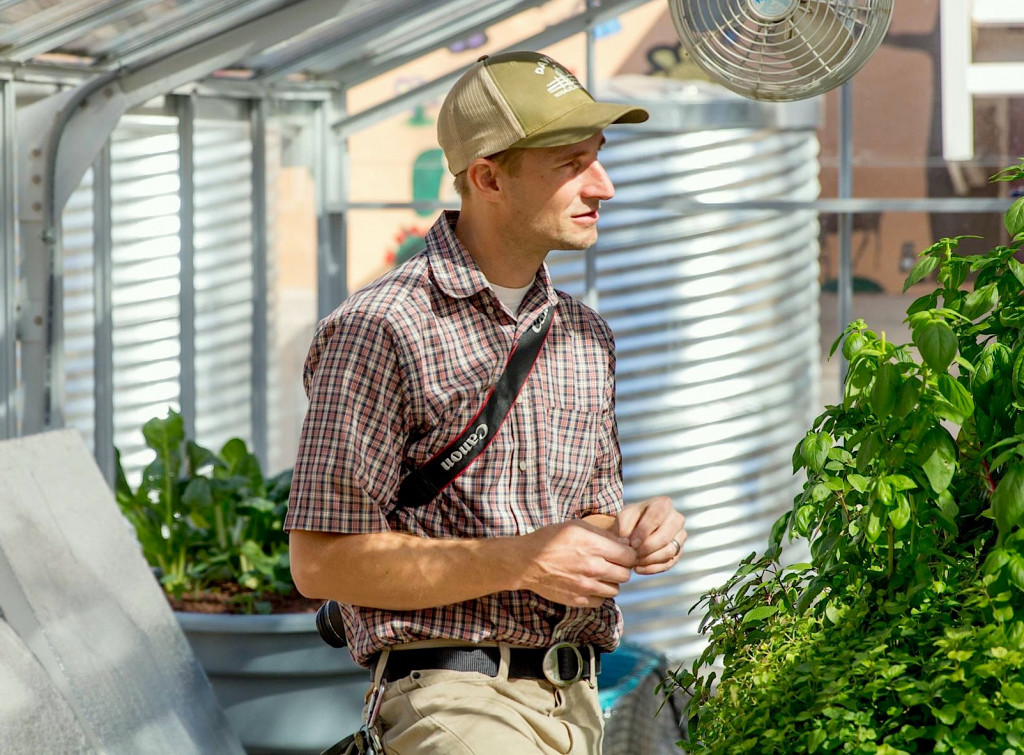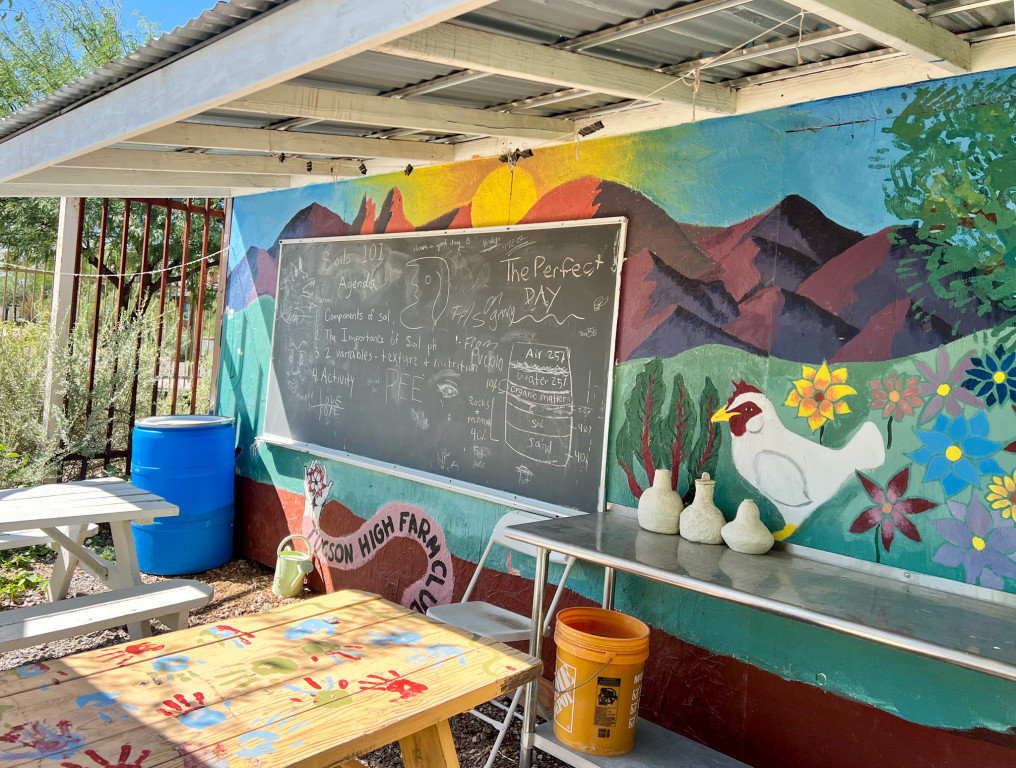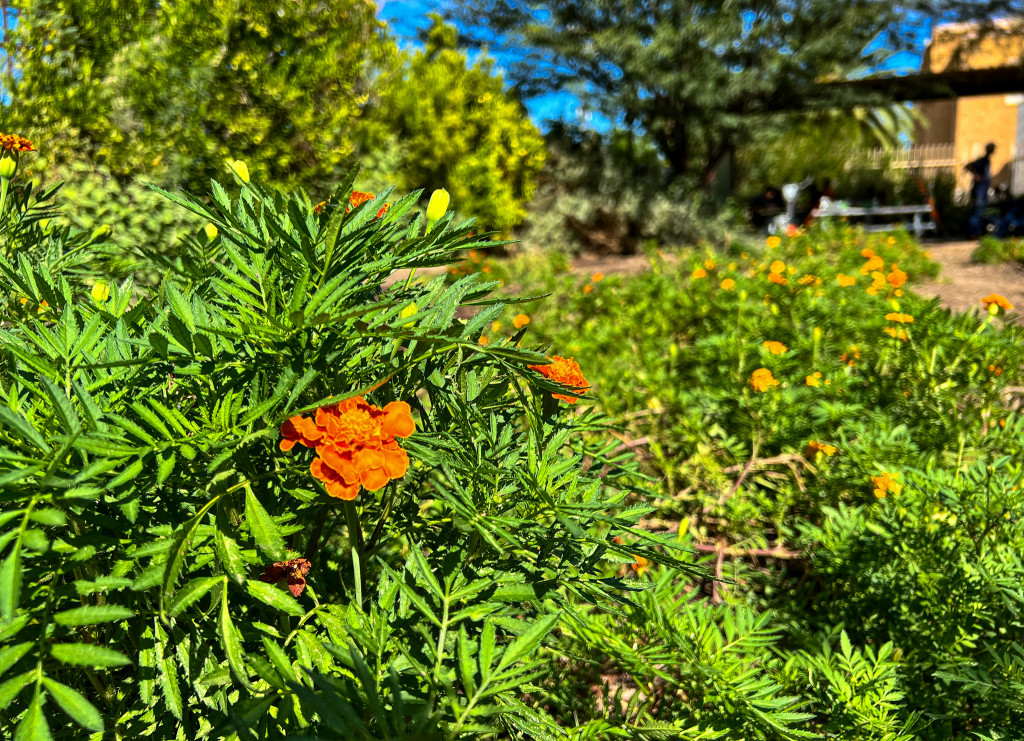
Moses Thompson walks down the garden beds at Tucson High School. (Photos by Halley Hughes/University of Arizona)

Moses Thompson walks down the garden beds at Tucson High School. (Photos by Halley Hughes/University of Arizona)
I walked from the blazing sun-baked streets of downtown Tucson, Arizona, into the school garden at Tucson High School. Immediately, I felt the air on my skin cool and my nose was filled with the scent of mesquite mulch. There was an unconscious relaxation of my body and mind as I embraced the space.
“Sorry I kept you waiting!” said a slim man in a worn baseball cap, jeans, and a T-shirt, as I approached the gate. I was here to meet Moses Thompson, the director of the Community School Garden Program (CSGP) in Tucson. His laid-back appearance and friendly demeanor was like a breath of fresh air.

The Community School Garden Program, led by Moses for the past two years, is run by the University of Arizona’s School of Geography. Under his leadership and the guidance of the founding director Sallie Marston, it has become an internationally recognized program. Its mission is to enable Tucson teachers and the community to develop and sustain gardens at school and at home. Focusing on the culture and politics of food, the program connects students to their communities and the world around them. It has trained more than 700 Tucson Unified School District K-12 educators and has produced over 8,500 hours of service. They estimate to have impacted over 600,000 students.
Moses is the heart of the program. His authenticity, humbleness, and kindness have cultivated a phenomenal CSGP team, many of whom grew up in the communities they now serve. Moses began his career as an elementary school counselor who integrated his love of nature into his counseling. He typically conducted sessions in an outdoor space at his school where the therapeutic qualities of nature made his students feel safe and at ease, allowing them to feel vulnerable and connect with him.

What made Moses — who had no previous gardening experience — take the leap from being an award-winning school counselor to running an equally awarded garden program?
“I knew close to zero about gardening before I started working with the CSGP,” he said. The project’s founder Sallie mentored him, and that expanded his idea of who he could be. Her advice to him was, “What you want now might not be what you want in five years,” which opened his mind to the idea of leadership.
I asked him how he handles the mantle of leadership and he said, “It feels heavy at times and I doubt myself, but the garden has taught me that skill sets aren’t static and with support and persistence I can navigate challenges. And at the end of the day, my love for the work and my love for the people I work with tamps down the fears and anxiety.”

Walking around the garden beds, it was hard to miss the big bushes of marigolds that demanded attention. “We plant a lot of marigolds,” Moses said, because the flowers prevent root pests, attract important pollinators, and deter caterpillars. These multitaskers are also beautiful.
Reflecting on my time in the garden, I realized that the program is just like the marigolds. The program produces crops, addresses social injustice, and encourages connection with heritage. The garden program is a source of food security, community knowledge, and a safe place for students and teachers. It also has the magical beauty that green spaces provide. It is a multitasker — just like the marigolds. Moses and the garden open doors to the most vulnerable among us and teach them to care for the Earth and themselves.
“How did you build all this? What is Moses Thompson’s mission?” I asked.
“What gnarly questions,” he said.
He leaned on his shovel and took a minute to think and then said, “I think when you get in a garden, something profound can happen. Growing food and eating consciously can make you feel different physically, and make you feel different about yourself. There is an unmatched capacity for change in a garden and I want to harness that by making gardening accessible to as many people as possible.”
I couldn’t help but smile.
“That’s incredible. Did you prepare all that in advance?”
“Oh god no,” he said, with a humble and embarrassed chuckle.
The Community School Garden Program is not something that can only bloom in Tucson. Moses emphasized that this program is a framework, one whose frame can be copied, rebuilt, and placed in other food-insecure areas looking to reconnect with their cultural heritage. Moses said the CSGP’s methodology is “throwing gas on a grassroots fire.” If the program expanded, it would be seeded with the unique heritage of that new place. A foundational part of the program is that each garden is rooted in the community so that when it develops its fruits, they are useful and familiar to those local to that place.
What is abundantly clear about Moses is that he cares deeply about our youngest generation. We talked about the climate crisis, how to fight it, and how to stay joyful doing it.
“Having no agency and feeling hopeless can make you paralyzed,” he said. “Here in the garden, you learn how to grow your own food, and sustain your own life, in harsh and demanding conditions. That gives you agency. It gives you self-confidence and self-worth. From a young age, you can see biodiversity and its benefits here, you can see ecosystem services.”
Moses’ philosophy seems to be working. Many of his students have gardens at home, too. He believes that the physiological and community benefits of gardens will build resilience and fight climate change.
Slideshow by Halley Hughes
Moses also gave me one of the kindest gifts I’ve ever received: the CSGP’s 2022 Almanac. However, this is no normal farmer’s almanac. It is an anthology soaked in the heritage of the Sonoran Desert and community love. Every page, every drawing, and every inclusion is so intentional in delivering cultural and ecological knowledge. Moses and his team knew they didn’t want the almanac to be a top-down intellectual product from the University of Arizona. He wanted kids to use the almanac, and to see their moms and other relatives in the pages.
That beautiful almanac now sits on my coffee table so that my home’s visitors can soak up the beauty of Sonoran heritage. What the CSGP has accomplished can be accomplished anywhere. By connecting with their communities and food, the generation that will experience climate change more prevalently than any other will be the navigators who lead us toward a hopeful future. Moses taught me that gardens are tools that can sow a generation of empowered children.